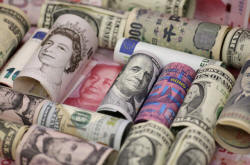|
Fed's Williams pushes
dollar down to one-month low vs. yen
 Send a link to a friend
Send a link to a friend
 [August 16, 2016]
By Patrick Graham [August 16, 2016]
By Patrick Graham
LONDON (Reuters) - The dollar fell across
the board on Tuesday, falling a full yen to a one-month low against the
Japanese currency and down against the commodity-linked currencies most
associated with growth and greater risk-taking by investors worldwide.
The greenback has been under pressure for the past week as the perceived
chances of a rise in U.S. interest rates this year took a knock from
several batches of data and the tone of some Federal Reserve
policymakers.
The trigger for its weakness overnight was a paper from San Francisco
Fed President John Williams arguing that central banks might have to
raise inflation targets, focus more on growth and back much looser
fiscal policy in future.
To market ears, that all added up to a strong argument for keeping the
Fed's rates unchanged for the foreseeable future and the dollar fell 1
percent against yen and around half a percent against the euro as Asian
and European markets came back online.
"The Williams paper yesterday was pretty dovish, so people are selling
dollars. Dollar yields are lower pretty much across the curve since the
release," said Citi strategist Josh O'Byrne.

Speculation of further aggressive monetary easing by Tokyo that would
weaken the yen was quelled by last month's Bank of Japan meeting, and
speculation on the chances of the government launching direct
intervention in the FX market has also eased.
"There is this feeling that Japan may not have that much left up their
sleeve and the Fed does seem to be backing off," said O'Byrne.
"The Japanese have been surprisingly quiet and people in general are
talking about (intervention) a lot less. Verbal intervention really
stepped up when we were seeing fast moves in the yen, and this has been
more of a grind, so it's harder for them to argue that there have been
disruptive markets."
The dollar traded as low as 100.15 yen, its lowest since the aftermath
of Britain's vote in June to leave the European Union. It weakened to a
7-week low of $1.1258 per euro <EUR=>, and by 0.5 and 0.7 percent
respectively against the Australian <AUD=> and New Zealand dollars.
[to top of second column] |

Euro, Hong Kong dollar, U.S. dollar, Japanese yen, British pound and
Chinese 100-yuan banknotes are seen in a picture illustration shot
January 21, 2016. REUTERS/Jason Lee

Against a basket of six major currencies, it lost 0.6 percent to 95.051
"The dollar is being weighed on by the limited appetite for Fed trades, and this
strength in emerging markets and the commodities currencies," said Stephen
Gallo, a strategist with Canada's BMO in London.
The markets will look to U.S. data later in the day including consumer prices,
housing starts and industrial output for another chance to gauge the health of
the economy.
The dollar will probably fall further against the yen over the next few months,
with the yen supported by factors such as Japan's rising current account
surplus, said Heng Koon How, senior FX investment strategist for Credit Suisse.
"Key risk to our view for more yen strength is of course more aggressive easing
by the Bank of Japan when they next meet," said Heng, who expects the dollar to
be trading at 96 yen three months from now.
"But so far this year, they have disappointed and failed to turn around
sentiment," he added.
(Additional reporting by Shinichi Saoshiro in Tokyo and Masayuki Kitano in
Singapore; Editing by Kevin Liffey)
[© 2016 Thomson Reuters. All rights
reserved.] Copyright 2016 Reuters. All rights reserved. This material may not be published,
broadcast, rewritten or redistributed.

  |